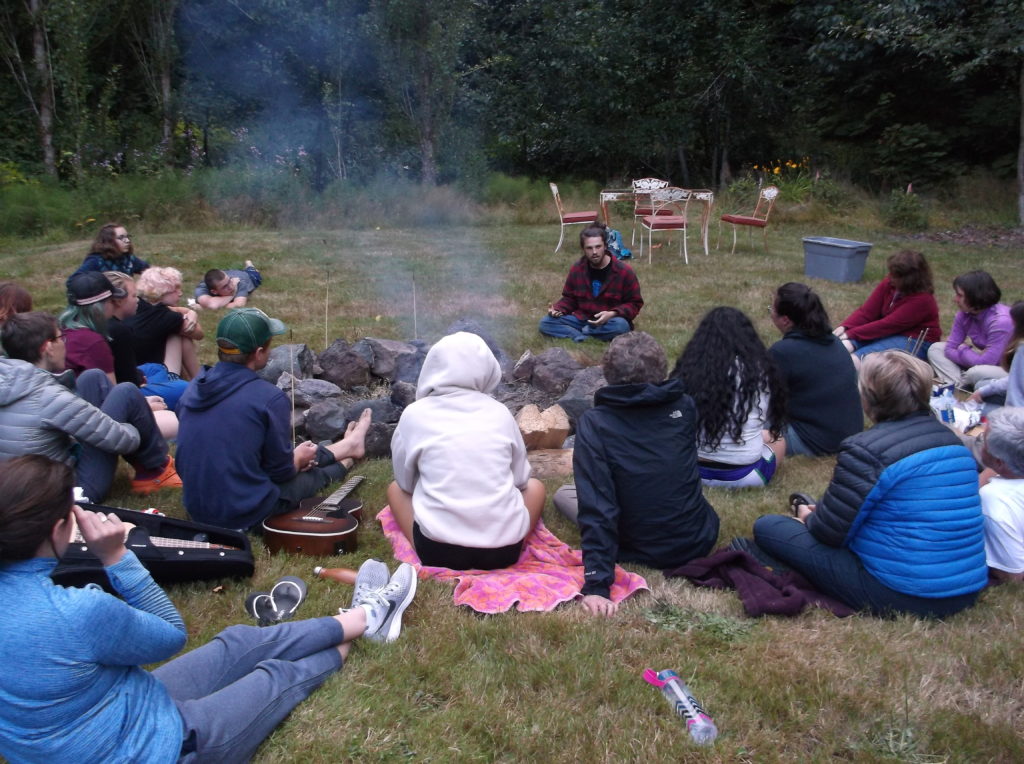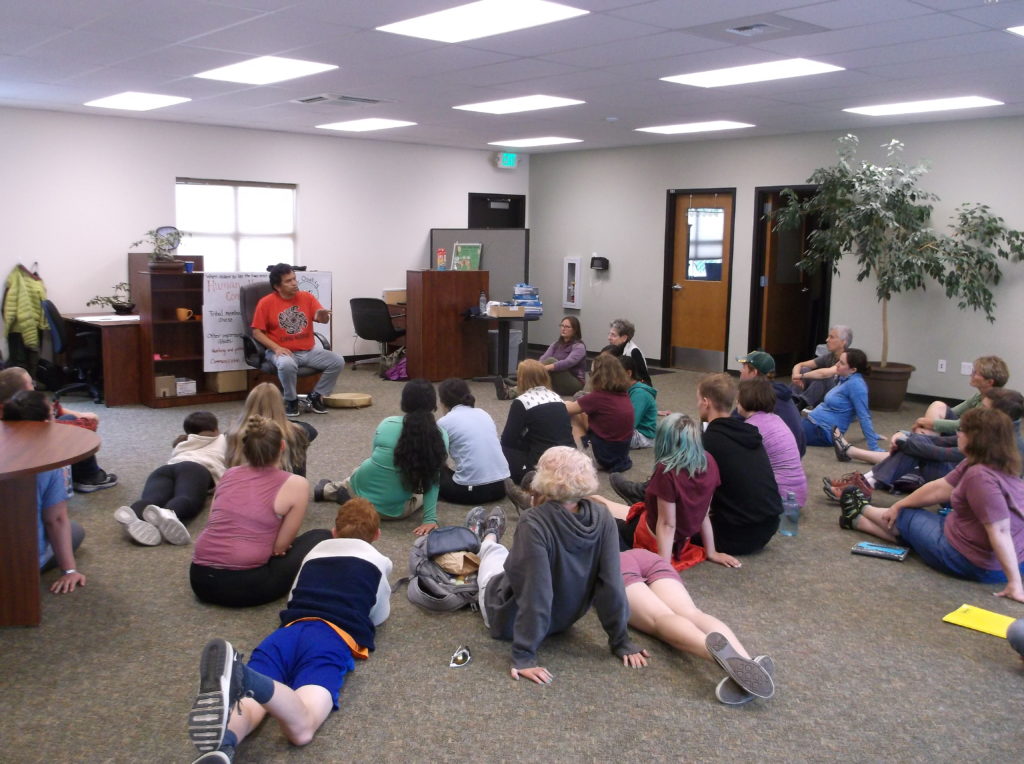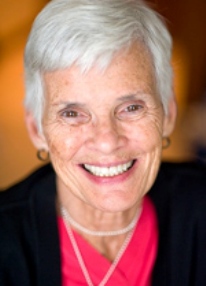How can you build a pilgrimage? Dr. Judith Mayotte provides all sorts of discussion questions and activities to enrich your DIY pilgrimages.
- Create a New Story: COVID–19, Racism, and the Cry of the Earth
- Resilience: Planting New Seeds
- Moments of Awe
- How Will You Live More Simply?
- Native American Wisdom
- Interconnectedness of All Things

Create a New Story: COVID–19, Racism, and the Cry of the Earth
There is such a connection between COVID-19, far-reaching racism, and dishonoring creation. In light of the fact that we cannot physically go on a Creation Care Pilgrimage this summer, look closely at the convergence of the above-mentioned factors right where you live.
It seems to me that Pope Francis’ challenge in his encyclical Laudato si to “hear the cry of the earth and the cry of the poor” (paragraph 49) could stand as a theme. We all want to build a world in which all creation can not only survive, but also truly thrive. How does hearing the cry of the earth and the cry of the poor challenge us? We know more Black, Indigenous, and People of Color (BIPOC) communities, just by their location, bear the brunt of industrial air pollution and fetid water. They lack access to green space and often feel a lack of safety in their neighborhoods. African-Americans have suffered more from COVID-19 due to the lack of access to good health care. More African-Americans serve the wider community in lower paying jobs—many of them essential jobs—and have felt more severely the brunt of the economic downturn. And, of course, the vile murder of George Floyd stands as symbol of more widespread police brutality.
Discussion Questions: Given the convergence of COVID-19, racism, and dishonoring earth, create a new story—a new narrative of our relationship with God, our fellow human beings, and nature, our common Earth home—so that humanity and all creation can live sustainably and peacefully. Might “virus” be an image for all three? Might “I can’t breathe” serve as an image for all three? Ask yourself what the world could be like if we truly “hear the cry of the earth and the cry of the poor” and accept the challenge to change. What sort of world would you like to see?

Resilience: Planting New Seeds
Read or view The Lorax by Dr. Seuss. In this book, Dr. Seuss portrays how out of greed and overconsumption of Thneed, produced from the properties of the Truffula Tree, a young lad finds the Once-ler who banked only on biggering and biggering and biggering now living in a denuded and devastated place bereft of a once abundant land of life and love. The Once-ler, finally realizing the error of his ways, tosses a small object to the lad. When he catches it, the lad sees that it is the one very last Truffula Tree seed. The Once-ler proclaims, “Truffula Trees are what everyone needs. Plant a new Truffula. Treat it with care. Give it clean water. And feed it fresh air. Grow a forest. Protect it from axes that hack. Then the Lorax and all his friends may come back.”
Discussion Questions: The earth and humans are resilient and robust if we are willing to plant the new seed in our hearts and minds, the new seed of caring for one another and the whole of creation. After reading The Lorax, what is one action you will take in planting a new seed of caring for your family, your friends and neighbors, and God’s good creation?

Moments of Awe
Moments of awe are a call to each of us to live the great commandment of love—love of God, our neighbors, and the whole of creation as ourselves—as stewards and, yes, co-creators of God’s good creation in new and transformative ways. Our caring for creation and our love of God and neighbor are integrally intertwined. God created a world that takes care of us and, in return, God asks us to take care of creation and each other.
Activity: There is so much we can learn from a walk in nature. I find the following exercise to be very helpful in learning how to look more carefully at and listen more fully to a specific piece of creation. I select a single tree, shrub, or bush or a specific spot beside a stream or body of water. Each day, I go to the same spot and look and listen to see what is the same and what is different, what is new to me that I did not see or hear the day before. For example, recently I saw how stamen in an azalea flower takes on the color of the blossom. I note what I see from day to day. By the end of the week, I have a fuller sense of the life and change that transpires in that single, beautiful piece of God’s creation. Following your week in viewing this slice of nature, express your moments of awe and discovery through a poem, a description, a story, a song, or a drawing.
Activity: You can spend a day or two in service: helping a neighbor in need, cleaning up an area in a park, working in a garden, talking with and learning from a friend or acquaintance who is of a different in race or religion. You can do this act of service in or near your home.

How Will You Live More Simply?
The time of the Coronavirus has brought clarity to our air and a forced simplifying of our lives. Slowing down gives pilgrims an opportunity to reflect on what it means to live a dignified human life. It can be a time to think about what we value. As pilgrims, we can imagine and believe that we can change the way we live with each other and with our Earth home. We can act with “heart and mind, wonder and technology, spirit and science.”
Discussion Questions: How might we as pilgrims reflect on these factors and grasp them as an invitation, an opportunity, to search for effective solutions to climate change? How might we see that we live in kinship with nature and with each other? That kinship is relational and reciprocal. The flourishing of the whole of creation requires mutuality—a give and take. What does it mean to live more simply? What difference will a circular economy, for example, make rather than our current linear, throwaway economy?

Native American Wisdom
In the Pacific Northwest, students have ample opportunity to think about the original lifestyle of our Native American sisters and brothers who acknowledged and embraced Mother Earth as sacred gift. Culturally and spiritually, native groups lived in a deep and abiding connection with the natural world. They took only what was needed from the Earth and respected the Earth’s need to renew and restore in order to continue giving its gifts from year to year and from generation to generation.
Discussion Questions: Might we pilgrims, as we walk in nature, learn to listen exquisitely to the land, to the water, to the air and to all the creatures on land and in waters? Might we reflect on the fact that we all breathe the same air? Might we reflect, too, on the wisdom of taking what Earth can give and still flourish, not demanding beyond Earth’s capacity? In so doing, pilgrims, we can understand the need to restore our forests, husband the land, keep fresh our waters—our oceans, rives and streams—and keep clean the air we breathe.

Interconnectedness of All Things
Consider the fact that the wellbeing of humanity is dependent on the wellbeing of nature. Everything we see around us comes from nature—from the carrots we eat to the cell phones we use to keep in touch with those we love. The fruits of Mother Earth feed both body and spirit. Nature is the source of humanity’s wealth and wellbeing. And all is interconnected and interdependent in the mysterious web of life. In the words of Pope Francis, “the climate is a complex system and a common good, belonging to all, meant for all, and needed by all for life to flourish.” (Laudato si, paragraph 23)
 Dr. Judith Mayotte is a humanitarian, author, theolo
Dr. Judith Mayotte is a humanitarian, author, theolo
